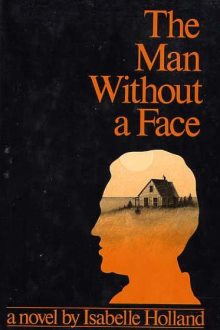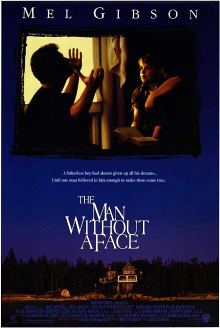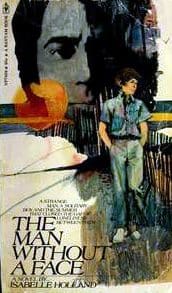 “It was the summer I was fourteen that I came to know The Man Without a Face.”
“It was the summer I was fourteen that I came to know The Man Without a Face.”
That’s the opening of The Man Without a Face, a book by the American novelist Isabelle Holland. Needless to say, the first person narrative won me over despite my suspicions of how credibly a woman author could address a memoir whose main protagonist is a young boy. But as I turned page after page my suspicion was replaced with appreciation. What’s more, for a book written back in early 1970’s, the world of the story felt contemporary – as if the action was taking place right now (as it will in the reader’s mind).
I need to disclose that though many of you will be familiar with Mel Gibson’s 1993 movie adaptation of the novel, I had not seen the film prior to reading the book.
The Man Without a Face is narrated in the first person by the 14-year-old Charles who, while spending the summer vacation at his family’s beach house, realizes that he desperately needs to get into boarding school in order to escape from his atrocious mother and sister.
“There’s no dignity in living crashed in a small pad with a bunch of women…”… “I couldn’t put up with that. I already felt I was drowning in women”.
At first, one may see Charles’s worries as a classic example of teenage whining or rebellion. As the story unfolds, one learns more and more details of Charles’s family life: a missing father, a jealous older sister and a critical mother with a passion for marriage experiments.
“Some women have gardening for a hobby, or good works, or art. Mother’s hobby is marrying.”
Who wouldn’t have wanted to escape?
But Charles is facing a serious challenge. He deliberately flunked the entrance exams for St. Matthews – the boarding school he was supposed to attend. Now he sees the school as a potential asylum, but his lack of good study habits (“I went to the kind of school in New York that would rather pass Rosie, the hippopotamus at the Central Park Zoo, than lose the tuition fee.”) is bound to get in the way of the intense preparation he needs for the re-sit exam at the end of the summer.

Just when the anxiety of his situation is about to overwhelm Charles, his younger sister (who unlike his older relatives he tolerates), shares with him a rumor than a local man known as The Grouch, alias The Man Without a Face, was once a teacher and might be willing to coach him. Charles hesitates: a loner living by himself in an old house on the peninsula, the Man Without a Face is subject to a lot of gossip. Half of his face is grotesquely deformed, yet no one knew how it had happened. But with his future at stake, Charles decides to give it a try.
Convincing The Man Without a Face (whose real name is Justin McLeod) to provide tutoring to Charles turns out to be a daunting task in itself. But McLeod eventually agrees.
The rest of the book is an exploration of the inter-generational relationship between Charles and McLeod, who acts as a strict authoritarian tutor (“…So with my usual luck I had found myself another Hitler…”), but at the same time is able to change the underachieving Charles and inspire in him student self-confidence.
“…About ninety percent of your time seems to have been spent resisting things and people, so that it’s now an emotional habit. It’s time you reached out on your own…”
To a certain extent Justin McLeod acts as a surrogate father to Charles, a welcomed role despite the boy’s initial take on such a relationship (“…I don’t need a stepfather and I don’t want one. I’ve had enough already….”). Charles learns to appreciate McLeod as friend:
“…I’d never known an adult I could communicate with or trust, and I communicated with him all the time, whether I was actually talking to him or not…”
 I will stop my description of the plot here in order to prevent slipping out a spoiler that could eventually ruin your reading experience. Yet, for the sake of objectivity, I have to mention that the story takes a rather controversial turn in the last pages of the novel. But this controversy does not lessen the beautifully crafted portrayal of Charles’s rite-of-passage experience. It felt easy to associate with his character and feelings (anger, determination, stubbornness, happiness or confusion). As he narrates his story, he often addresses his listeners (readers), which further reinforces the intimacy of the novel.
I will stop my description of the plot here in order to prevent slipping out a spoiler that could eventually ruin your reading experience. Yet, for the sake of objectivity, I have to mention that the story takes a rather controversial turn in the last pages of the novel. But this controversy does not lessen the beautifully crafted portrayal of Charles’s rite-of-passage experience. It felt easy to associate with his character and feelings (anger, determination, stubbornness, happiness or confusion). As he narrates his story, he often addresses his listeners (readers), which further reinforces the intimacy of the novel.
The Man Without a Face features a captivating, realistic story told in an emotive manner. It’s filled with witty humor, which makes for an enjoyable read. The seemingly simple story turns out to be more complex than one first imagines, especially when it comes to the exploration of the interpersonal relations that are abundant in the story (with an emphasis on the one between McLeod and Charles).
Despite the fact that The Man Without a Face is recommended for young readers [1972 Best Books for Young Adults, Best of the Best Books 1970-1983 (ALA), Outstanding Children’s Books of 1972 (NYT)], I feel that adults are more likely to appreciate the narrative and fully grasp the complexity and subtle nuances present. As with most Coming-of-Age literature, nostalgia will play its role in the overall enjoyment of the book as well.
Recommended!